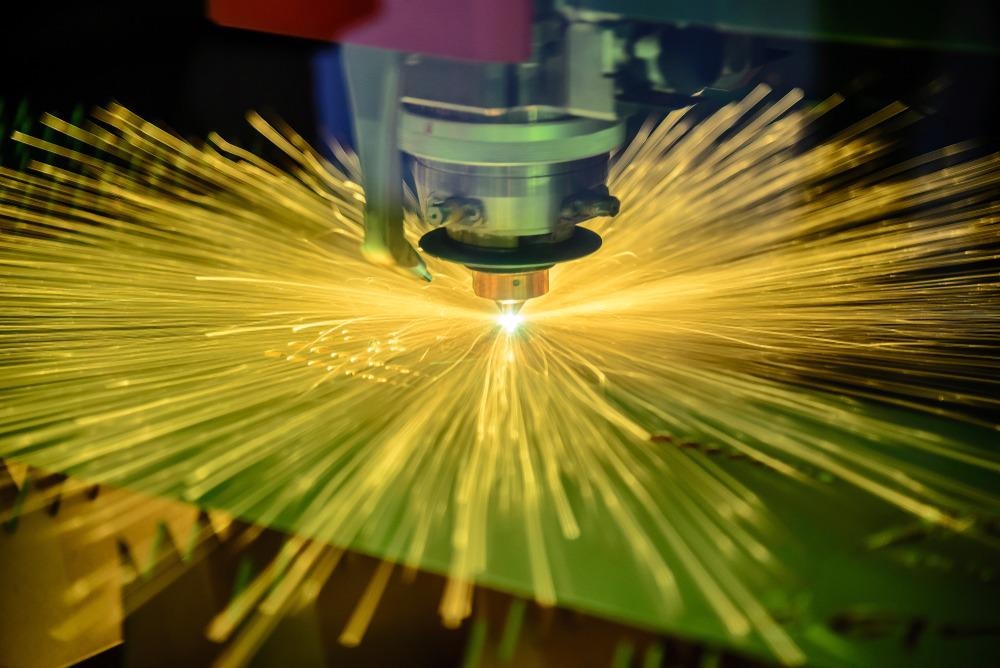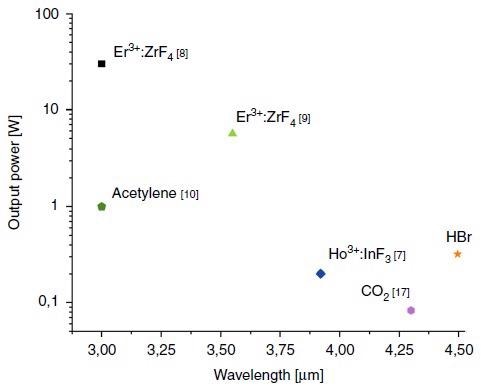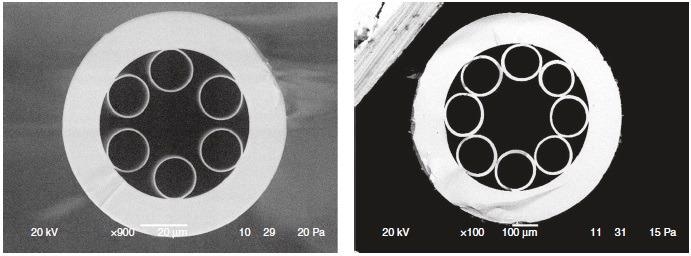It is well understood that the advancement of discrete and tunable mid-IR laser radiation sources has a long tradition. The creation of quantum cascade lasers, vibronic state lasers, and optical parametric oscillators laid the foundation for mid-IR photonics. Each of these solid-state mid-IR lasers has benefits and drawbacks. This article looks at research published in Light: Science & Applications, titled 'Gas fiber lasers may represent a breakthrough in creating powerful radiation sources in the mid-IR'.

Image Credit: Pixel B/Shutterstock.com
In the continuous wave (CW) mode, quantum cascade lasers made of quantum semiconductor structures, for instance, can encompass the spectral range from the mid-infrared to the sub-millimeter.
However, the heat issue creates significant challenges in the development of high-power mid-infrared light sources. Even though the other solid-state laser sources in the mid-IR spectral range discussed above have sufficient effectiveness for commercial uses, significant drawbacks such as a narrow linewidth and linear polarized excitation for parametric generation remain common.
The growth of advanced fiber lasers functioning in the mid-infrared spectral range has risen significantly in the past decade thanks to a rapidly maturing soft-glass fiber fabrication technology.
Soft glass optical fibers have considerably lower phonon uptake in the mid-IR spectral range than silicate glass or rare-earth-doped silica glass fibers, and thus significantly lower material losses.
Due to this, they can be actively used to create power fiber lasers in the mid-IR4. Fiber lasers centered on fluoride glasses have proven especially effective.
Erbium-doped fluorozirconate glass fibers, for example, are permitted to produce 30 W mid-infrared laser output power at a wavelength near 3 μm and watt-level fiber laser output power at wavelengths up to 3.55 μm (Figure 1). The fluoride fiber laser generated the longest wavelength in the mid-IR at 3.92 μm using a massively holmium-doped fluoridate fiber and a CW output power of 200 mW7 (Figure 1).
With the advancement of hollow-core fiber technology, the situation in the field of mid-IR fiber lasers started to change significantly. This became especially clear after the development of “negative curvature” or “anti-resonant” hollow-core fibers (Figure 2).
The researchers of a recent paper reported in Light: Science and Applications set the goal of developing a CW fiber laser based on silica glass hollow-core negative curvature fiber that operates with the maximum possible output power at wavelengths higher than 4 μm over the widest tuning range. Researchers used a population inversion caused by HBr molecules’ intrinsic absorption.

Figure 1. Continuous wave mid-IR fiber lasers. Summary of the state-of-art continuous wave mid-IR fiber lasers in terms of output and lasing wavelengths. Image Credit: Pryamikov, A., 2022

Figure 2. Cross-sections of the negative curvature hollow-core fibers made of silica glass (left) and chalcogenide glass (right). The fibers were fabricated at Dianov Fiber Optics Research Center. Image Credit: Pryamikov, A., 2022
Results and Discussion
The researchers used a narrow linewidth 2 μm thulium-doped fiber amplifier planted by a group of fine-tunable diode lasers to pump a 5-meter-long silica glass hollow-core fiber with a cross-section similar to the hollow core fibers illustrated in Figure 2 (left) in their new work.
In addition, among CW fiber lasers, a laser output of about 300 mW was achieved at the longest wavelength of 4.496 μm (Figure 1).
The circumstance can also be improved by developing hollow-core fibers made of non-silica glasses such as tellurite glasses or chalcogenide glasses. Their use will substantially reduce material losses in the fiber cladding in the mid-IR spectral range, allowing for CW laser generation at wavelengths higher than 4.5 μm. Tellurite hollow-core fibers have so far been created using the extrusion and draw method.
At 5.6 and 5.8 µm, respectively, fiber losses of 4.8 and 6.4 dB/m were measured. According to the researchers, this raises the prospect of fabricating tellurite hollow-core optical fibers with sub 1–2 dB/m loss within the technologically important spectral region between 4.5 and 6.5 µm in the coming years.
The researchers explain the creation of a hollow-core fiber drawn from a 3D-printed chalcogenide glass preform. Several transmission bands were observed in this fiber’s spectral range of 2–12 µm.
Conclusion
Eventually, in the mid–IR spectral range, CW gas fiber lasers based on the new type of hollow-core fibers are emerging as a market player to their rare-earth-doped counterparts. They may become a viable option for other fiber lasers for generating CW coherent light sources in the mid–IR spectral range in the coming days.
Journal Reference:
Pryamikov, A. (2022) Gas fiber lasers may represent a breakthrough in creating powerful radiation sources in the mid-IR. Light: Science & Applications, 11, p. 36. Available Online: https://www.nature.com/articles/s41377-022-00728-5.
References and Further Reading
- Faist, J., et al. (1994) Quantum cascade laser. Science, 264, pp. 553–556.
- Deloach, L. D., et al. (1996) Transition metal-doped zinc chalcogenides: spectroscopy and laser demonstration of a new class of gain media. IEEE Journal of Quantum Electronics, 32, pp. 885–895. doi.org/10.1109/3.502365.
- Vodopyanov, K. L (1999) Mid-infrared optical parametric generator with extra-wide (3–19-μm) tunability: applications for spectroscopy of two-dimensional electrons in quantum wells. Journal of the Optical Society of America B, 16, pp. 1579–1586. doi.org/10.1364/JOSAB.16.001579.
- Jackson, S. D (2012) Towards high-power mid-infrared emission from a fibre laser. Nature Photonics, 6, pp. 423–431. doi.org/10.1038/nphoton.2012.149.
- Falconi, M. C., et al. (2017) Advances in mid-IR fiber lasers: tellurite, fluoride and chalcogenide. Fibers, 5, p. 23. doi.org/10.3390/fib5020023.
- Tao, G. M., et al. (2015) Infrared fibers. Advances in Optics and Photonics, 7, pp. 379–458. doi.org/10.1364/AOP.7.000379.
- Maes, F., et al. (2018) Room-temperature fiber laser at 3.92 μm. Optica, 5, pp. 761–764. doi.org/10.1364/OPTICA.5.000761.
- Fortin, V., et al. (2015) 30W fluoride glass all-fiber laser at 2.94 μm. Optics Letters. 40, pp. 2882–2885. doi.org/10.1364/OL.40.002882.
- Maes, F., et al. (2017) 5.6W monolithic fiber laser at 3.55 μm. Optics Letters, 42, pp. 2054–2057. doi.org/10.1364/OL.42.002054.
- Xu, M. R., et al. (2018) Continuous-wave mid-infrared gas fiber lasers. IEEE Journal of Selected Topics in Quantum Electronics, 24, p. 0902308. doi.org/10.1109/JSTQE.2018.2792842.
- Pryamikov, A. D., et al. (2011) Demonstration of a waveguide regime for a silica hollow-core microstructured optical fiber with a negative curvature of the core boundary in the spectral region >3.5 μm. Optics Express, 19, pp. 1441–1448. doi.org/10.1364/OE.19.001441.
- Wang, Y. Y., et al. (2011) Low loss broadband transmission in hypocycloid-core Kagome hollow-core photonic crystal fiber. Optics Letters, 36, pp. 669–671. doi.org/10.1364/OL.36.000669.
- Yu, F., et al. (2012) Low loss silica hollow core fibers for 3–4 μm spectral region. Optics Express, 20, pp. 11153–11158. doi.org/10.1364/OE.20.011153.
- Kolyadin, A. N., et al. (2013) Light transmission in negative curvature hollow core fiber in extremely high material loss region. Optics Express, 21, pp. 9514–9519. doi.org/10.1364/OE.21.009514.
- Debord, B., et al. (2013) Hypocycloid-shaped hollow-core photonic crystal fiber Part I: Arc curvature effect on confinement loss. Optics Express, 21, pp. 28597–28608. doi.org/10.1364/OE.21.028597.
- Aghbolagh, F. B. A., et al. (2019) Mid IR hollowcore fiber gas laser emitting at 4.6 μm. Optics Letters, 44, pp. 383–386. doi.org/10.1364/OL.44.000383.
- Cui, Y. L., et al. (2019) 4.3 μm fiber laser in CO2-filled hollow-core silica fibers. Optica, 6, pp. 951–954. doi.org/10.1364/OPTICA.6.000951.
- Gladyshev, A. V., et al. (2017) 4.4-μm Raman laser based on hollow-core silica fibre. Quantum Electron, 47, pp. 491–494. doi.org/10.1070/QEL16400.
- Astapovich, M. S., et al. (2019) Watt-level nanosecond 4.42-μm Raman laser based on silica fiber. IEEE Photonics Technology Letters, 31, pp. 78–81. doi.org/10.1109/LPT.2018.2883919.
- Zhou, Z. Y., et al. (2022) Towards high-power mid-IR light source tunable from 3.8 to 4.5 μm by HBr-filled hollow-core silica fibres. Light: Science & Applications, 11, p. 15. doi.org/10.1038/s41377-021-00703-6.
- Tong, H. T., et al. (2019) Mid-infrared transmission by a tellurite hollow core optical fiber. Optics Express, 27, pp. 30576–30588. doi.org/10.1364/OE.27.030576.
- Ventura, A., et al. (2020) Extruded tellurite antiresonant hollow core fiber for mid-IR operation. Optics Express, 28, pp. 16542–16553. doi.org/10.1364/OE.390517.
- Carcreff, J., et al. (2021) Mid-infrared hollow core fiber drawn from a 3D printed chalcogenide glass preform. Optical Materials Express, 11, pp. 198–209. doi.org/10.1364/OME.415090.